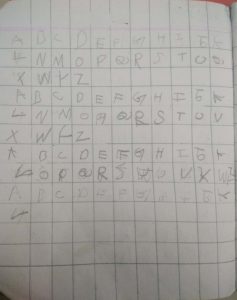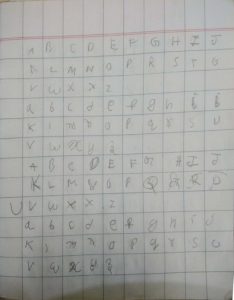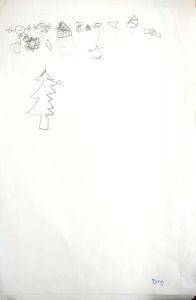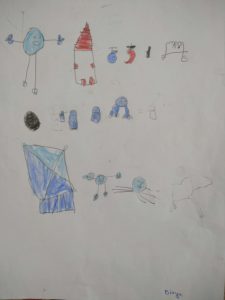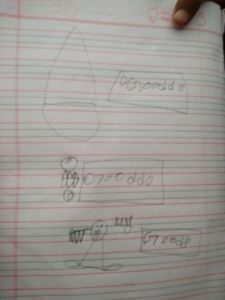What do Children Write in Class?
In recent times, there has been a shift in focus of writing from mainly copying words and sentences, simply improving handwriting skills to writing for expressing ideas, communicating thoughts and meaningfully engaging with writing. Recent research in children’s writing has shown that children should be given an environment in which writing has meaning for children. Writing instruction should be such that it encourages children to understand what role does writing play in their life.
In order to get some understanding of what is happening in the field, an investigation was undertaken to explore what kind of writing tasks do children engage with in the primary grades (grade I to grade V) of one of the schools, ELI is working with. For the purpose of this investigation, five children’s English notebooks from each grade I to grade V were selected from one of the four government schools, my teammate and I have been working with the teachers in teaching English for the past few months. Here, I will also take the liberty of sharing some of my observations and experiences of working with these four government schools’ grade I teachers in teaching English in the classroom, to reflect upon children’s writing in learning a second language.
Grade I classrooms of these four sample schools in Hyderabad have 20 to 30 children, on an average, and they belong to diverse linguistic backgrounds. It has been observed that there are a majority of Telugu language speakers, followed by speakers of other languages like Hindi, Urdu, Lambada and others. The teacher mostly conducts classes in Telugu and occasionally includes other languages during discussion. Children in these schools have little or no exposure to the English language, outside the classrooms. Due to such limited exposure to oral language, and children not being adequately proficient in English language, we restrained from engaging with any writing tasks. Writing can be meaningful only if the child understands at least the structure of language, and can make sense of what he/she has written.
Although, we had a discussion with the teachers regarding this challenge, teachers seemed to have different beliefs about writing. Some of these beliefs have been:
‘By the end of grade I children should know how to write the alphabet.’
‘Children should practice writing to improve their handwriting.’
‘Children have to write alphabet or spellings of some words as homework.’
‘Children this young cannot write.’
With these teachers’ beliefs, there was a need felt to examine children’s notebooks and understand how these beliefs were shaping up the writing instructions and tasks. Five notebooks were randomly collected from each grade I to grade V of one of the schools we were working with.
The notebooks presented a glimpse of the kind of writing tasks children were engaging with on almost a daily basis. Table below describes the nature of tasks observed in the notebooks.
| GRADE | NATURE OF TASKS |
| Grade I |
Practiced writing the alphabet
Repeating spellings of words from only the first chapter of the book – Ammu, Bittu, book, cat, dog, family. ‘Father’ and ‘Mother’ were written both in English and Telugu. Only some children have practiced writing their names |
| Grade II |
Simple antonyms
Copied sentences from the book or other sources like the blackboard. Practiced writing the alphabet. |
| Grade III |
Copied lessons from the book
Practiced spellings of words. |
| Grade IV |
Copied lessons from the book.
Copied questions and answers from blackboard. Copied words and their meanings from the book. |
| Grade V |
Copied lessons and poems from the book.
Copied questions and answers from the blackboard Copied exercises given in the book. Some children practiced writing small letters of the alphabet. |
Can you identify something that is common across all the grades?
The nature of the tasks is fairly common across all the grades. No matter in which class, children, are engaging in mechanical writing that includes copying from different sources like the textbook, or blackboard; or repetitively writing of the alphabet, or spellings. Children may have moved from writing words to sentences to full text from the lesson from grade I to grade V, but, how does it influence children’s learning?
We have tried to understand the nature of the task from the notebook, we will now look at the responses of children on these tasks to get a better understanding. I will share some samples of the nature of children’s responses and samples of their writing and make an attempt at analyzing these samples.
Children in grade I had written the alphabet multiple times, that was mostly given to them as part of their homework by the teacher. The letter formations may not be fine, and some letters may look more like scribbles. However, before we penalize children for not writing ‘correctly’, we need to understand that children go through developmental stages of writing. Children as young as five to seven years old are still in their emergent writing phase, where they are getting used to using the pencils, and are slowly moving from lower-appearing form like scribbling to making letter like forms, which can be seen in the sample below.
Besides letters, children’s notebooks also showed that they have practiced writing some words from the first chapter of their school book. Some of these words were Bittu, Ammu (characters in the book), cat, dog, book, family, father, and mother. Some of these words may be relatable to children, and hence, easier to grasp in English. However, I feel that instead of just asking the children to keep repeating writing the words, children could have been given an opportunity here to explore writing the words in their own ways. They might scribble the word, or make drawings or would have tried to invent their own spellings, but would have experimented with writing and hence, it would have been a more meaningful experience. I wonder how many of these children can recall any of these spellings or letters when asked later on. We need to think if these kind of tasks serve any purpose for language learning and writing?
From grade II onwards, children’s notebooks are filled with text copied from different sources like the textbook and blackboard. The text varies from sentences, to lesson, to question and answers. And handwriting becomes more legible as we progress from grade II to grade V. Again, we need to pause and think here about the purpose of writing in classrooms – is the purpose of writing copying few sentences and lessons, repeating some words, improving handwriting (as teacher limits her comment to handwriting in one of the samples) or should it be something more meaningful, contextual and relevant to the child?
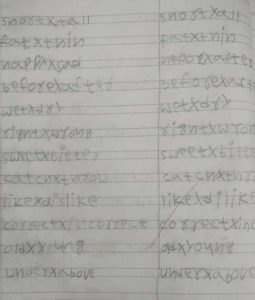
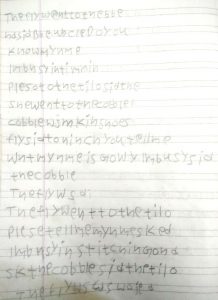
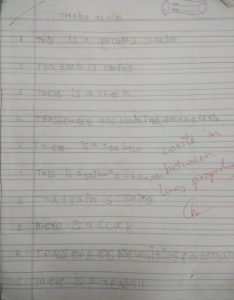
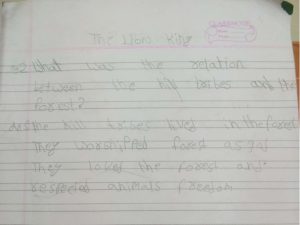
Having some understanding of teacher’s ideas about writing, which are shared above and going through the analysis of their notebooks, one can infer that the focus of writing is merely restricted to copying and repeating some text. These kinds of tasks may be helpful in developing skills of writing legibly or maybe recognizing some words later, but nothing more than that. These tasks make writing more detached from the children’s context and makes writing meaningless to them. Now, we need to think about how we can make space for children to meaningfully engage with writing.
While supporting teachers with teaching English, we made an attempt to include some drawing tasks to allow children to express themselves and to explore drawing for teaching language. During some of these tasks, I observed that students liked to draw tiny images that are usually arranged in a line. It is almost as if these tiny images are words and strung together like a sentence. However, instead of probing the child about her style of drawing, the teacher insisted upon drawing images of larger size. The student hesitantly obeyed the teacher and tried to draw pictures accordingly. How did this incident influence her? I felt that she was somewhat hesitant now in expressing herself in the class. Children go through development phases in writing, they may not draw as adults expect them to, but adults can make use of this opportunity to probe children’s thinking and language learning. But, the teacher preferred to let children copy the pictures and the words related to it from the blackboard. We were trying to help children freely express their thoughts, but such events only restricted the student.
During another class, children were asked to draw characters from the story, that was read aloud to them by the teacher. The child labelled all his drawings as ‘Goodu’ (egg in Telugu, referred to mother bird’s egg in the story). There was an attempt made by child to write something that may not make much sense but instead of appreciating his efforts, the teacher laughed at him and sent him away.
These are some of many such events where teacher has failed to use the opportunity at hand of supporting children in engaging with meaningful writing experiences. From these personal experiences of being in the classroom and of analyzing the notebooks, I feel that there is a need to think about how an environment can be created to encourage children to write more meaningfully, to express their ideas and communicate their feelings.
Some of the ways I can think of are:
- Creating a writing center in class which is equipped with different kinds of papers, writing material, the alphabet and providing children with daily opportunities to visit the center.
- Children should be allowed to share what they have composed. It could be their drawings, scribbles, or letters, which may not be ‘correct’ for an adult, but are means of expressing their ideas.
- Children should be given space and be encouraged to engage in invented spellings.
- Engaging in shared writing, where teacher scribes what children say aloud.
For more writing, you can look at the resources.
